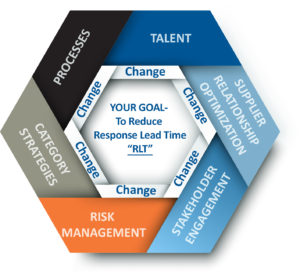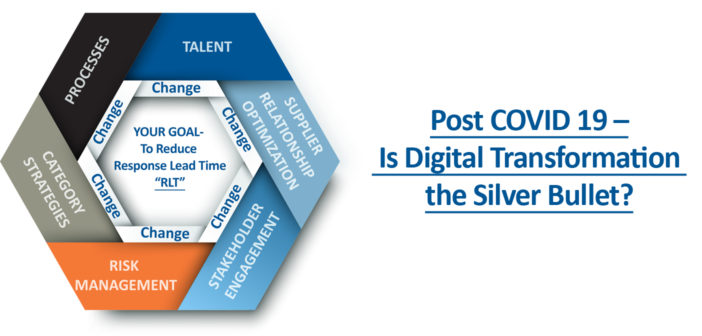The last 90 days have tested our Supply Chains like never before, and ALL organizations have one. Whether you are a manufacturer or a restaurant or a retailer or a university or a professional service organization, your Supply Chain was most certainly disrupted or at least shaken by COVID-19. Those organizations that had little to no digital capability prior to COVID found themselves in a mad scramble to quickly increase that capability. Restaurants offered on-line ordering, universities that had no on-line courses were forced to teach on-line, some within a week and so on and so on. Many organizations did whatever it took to ensure they provided access to their customers in an environment where staying at home was required. Technology certainly helped in providing many organizations the resiliency and agility to get thru the last few months but is digital transformation the silver bullet for those same organizations going forward? I would argue – it depends.
We know that most of our organizations were ill prepared for COVID and another “COVID” IS right around the corner so, as Supply Chain professionals, we need to take a careful look at our gaps and blind spots. A recent article in Forbes, “Post COVID-19, The Answer is Digital Transformation, Now What’s the Question?” advocates that Digital transformation is certainly the answer, albeit the author is specifically suggesting this for manufacturers. Here is one of the arguments he lays out, “ For too long supply chain management and the procurement process has relied on sending out numerous requests for quotation (RFQs), spreadsheets to manage those responses, long haul business travel to audit suppliers, late night conference calls and long- distance program and quality management. COVID-19 has shone a spotlight on these outdated supply chain management techniques and found them wanting. They have been exposed as lacking visibility, lacking adaptability or agility and sadly lacking the resilience needed to cope with even minor disruptions. And it isn’t as if there is no alternative, new tools have existed for some time. Supply chain software has been developed that helps manage purchasing, supply chain, inventory, all more dynamically and in real time.” I would bet that those organizations that have already implemented new P2P or S2S (Supply Chain) software were no more prepared than the rest. So, is Digital transformation the answer?
Change is necessary, maybe even complete transformation, but technology in and of itself IS NOT the solution. Digital transformation is hard, expensive and complex and takes years to get it right. I would argue that we, as a profession, need change NOW to remain relevant for our organizations. Here are a few things we believe need to change immediately:

By the way, ALL these elements need to be thought through, designed and in place before you even consider a digital transformation. We have taken our maturity model and hiked up the expectations for Sourcing / Supply Chain organizations as a result of COVID-19. Here is a sample of those expectations:
Talent
- Strategic competencies (including supply chain thinking) take center stage and ALL employees must be educated
- Strategic workforce planning focuses on flexible staffing and resiliency (permanent, temporary, consultants)
- Recruiting is strengthened beyond local resources as remote work becomes the norm
Supplier Relationship Optimization
- Top Tier Suppliers are identified and nurtured as an extension of your company
- New metrics in place to assess Response Lead Time (Resiliency & Agility) for both Parties
- Relationship is measured by collaboration / cooperation from both parties during economic downturns
Stakeholder Engagement
- Top Tier Suppliers are identified and nurtured as an extension of your company
- New metrics in place to assess Response Lead Time (Resiliency & Agility) for both Parties
- Relationship is measured by collaboration / cooperation from both parties during economic downturns
Risk Management
- Establish a cross-functional response team (e.g. planning, procurement, manufacturing, distribution, legal and finance) and operating rules for immediate response to risk events
- Risk management uses a portfolio approach and is analyzed by supplier, industry, country, region, etc.
- Assess disruption on products, services and supply chains using advanced analytics. Prioritize risks and identify blind spots
Category Strategies
- Supply Chain thinking / modelling is built into all category strategies
- Establish diversity and redundancy in the supply base (small vs. big, local vs. regional vs. global)
- Demand planning & forecasting is demanded by Sourcing / Supply Chain and integrated into all category strategies
Processes
- Scenario planning is the norm and critical to ensure agility and resiliency
- Strategic processes (Change management, risk management and relationship management) are built into the Category Management process
- Technology is strategically utilized in the integration of business processes to eliminate waste & manual intervention
Please note that technology is one of many changes that are required. Make no mistake, change is necessary but before we start shouting “Digital Transformation”, let’s understand that there is no silver bullet here.
Stay safe everyone, let us know what you think and join in the conversation . . . . .

